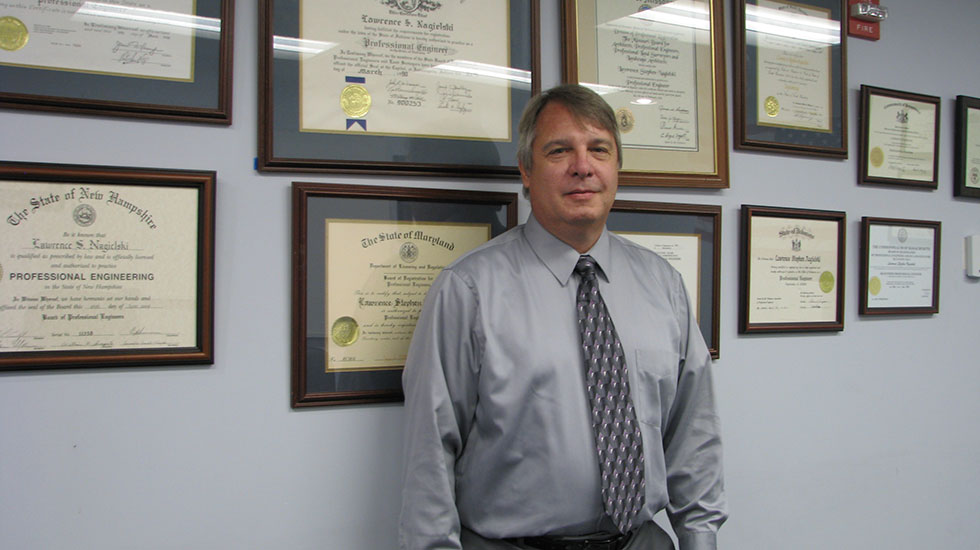Lawrence S. Nagielski, P.E., President & Managing Principal, Meyer Consulting Engineers Corporation
Nagielski joined Meyer Consulting Engineers (then known as Meyer Associates) in 1985 as a junior staff structural engineer and steadily rose through the ranks, now functioning as the firm’s president and managing partner. His company specializes in structural engineering and construction quality control with an employment complement of over 40 personnel.
Nagielski brings over 35 years of design experience, is licensed to practice engineering in over 20 states, and is responsible for the design and/or inspection of over 400 projects per year. This work includes retail and commercial, residential, office buildings, parking garages, military and infrastructure projects (including new construction), renovations and additions, and highly specialized forensic studies. His clientele includes Federal Realty Investment Trust, Pennsylvania Real Estate Investment Trust, Developers Diversified, Simon Property Group, Regency Centers, and Erickson Living.
Nagielski is a member of Tau Beta Pi (National Engineering Honor Society), Chi Epsilon (Civil Engineering Honor Society), the American Institute of Steel Construction, the American Society of Civil Engineers and the National Society of Professional Engineers. He holds a Bachelor of Science in Civil Engineering from Tri-State University and a Master of Science in Structural Engineering from The George Washington University.
What made you decide to get into engineering?
Engineering shapes and enhances our lives every day. It is the science of the possible. Being part of that experience is exhilarating while at the same time sobering realizing that I am directly responsible for public safety on every project my company undertakes. My firm was one of the first evaluating the structural stability of buildings after Hurricane Katrina and evaluating the safety of all schools in the city of Alexandria, VA after the 2011 earthquake. Currently, we are working on a major expansion at Reagan National Airport.
What pushes you to the next level?
The opportunity to do something new and exciting! We were recently involved in a project in Washington, D.C. where the developer wanted to construct a new high-rise apartment building atop an abandoned underground parking garage. This does not happen every day. We had to evaluate the condition of existing construction first, strengthen it where necessary, and then meld the configuration of existing construction to a new superstructure framing grid that did not align with that of the garage. The complexity of this was such that we won a prestigious design award.
What inspires you?
Working with talented architects. As structural engineers, we are responsible for making the building standing up. Architects are responsible for form and function. One of my favorite small projects was a retail center in Abington, PA. It was an existing shopping center that was a drab series of blocks. The architect, who was very creative while operating on a tight budget, introduced a series of arched steel joists that totally transformed the property. Some of these joists had a structural function, which allowed us to get into the act too!
Do you have a favorite or residential project?
For a retail project I would pick the one-million-square-foot expansion of Plymouth Meeting Mall in Pennsylvania. Did you know that this retail complex was the site of the first Ikea in the U.S. and has its own church within the mall? The expansion was an elevated deck with on grade parking below and retail on top. PREIT, the developer, generally owns to keep, so we were careful to select a podium framing configuration that would be amenable and easy to change in the future—particularly floor loading upgrades that have become so common in the industry. It’s important to be able to do this quickly and inexpensively in the retail world.
My favorite residential project would be Erickson’s Ashley Ponds retirement campus in Ashburn, VA. This is a gated, self-contained community made up of a series of midrise residential neighborhoods connected by conditioned on-grade links and pedestrian bridges. One never has to go outside if they don’t want to. We have been providing structural design here for well over 10 years as the neighborhoods are phased in. It’s the definition of backlog.
If you had to work in a city other than D.C., where would it be?
How could you say no to New York, the economic capital of the world? But I grew up in the suburbs of Cleveland, OH and I would rather be back home.





















Add Comment